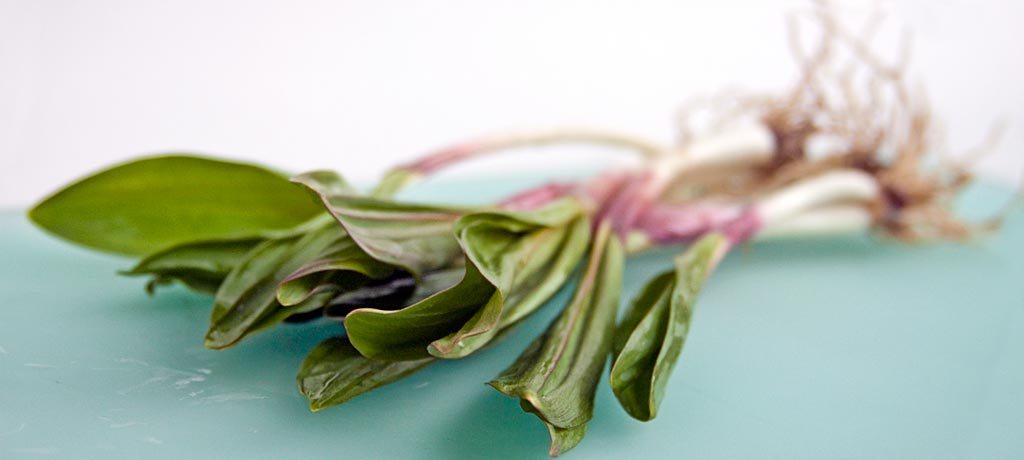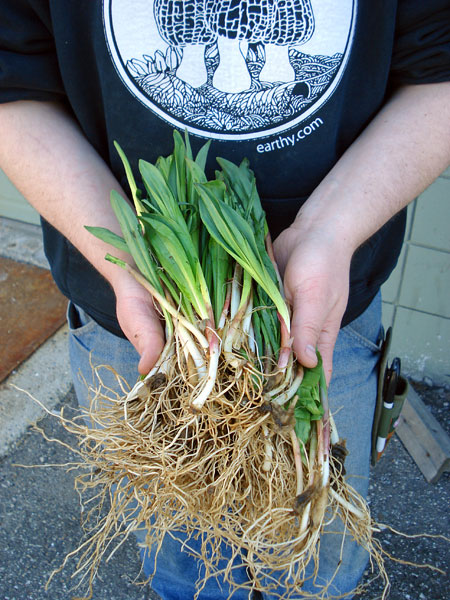Ramps / Wild Leeks (Allium tricoccum)
Ramps and Wild Leeks are the same plant, a type of wild-growing onion generally presented fresh with the green leaves attached to the small white bulb.
Ramps and Wild Leeks are distinguished primarily by growing in different regions. Where they are found growing in the Appalachian range they are known as Ramps. Harvest in this region typically begins around the middle of April. A few weeks later they are harvested in the Great Lakes region where they are called Wild Leeks. There are slight differences between the products in that the Wild Leeks generally have a larger bulb and a slightly milder flavor, especially in the leaf portion.
Where Ramps grow they are the healer, solace and friend to Mountain Folks. Ramps are folk medicine said to keep away cold, flu and the neighbors! They are Spring Tonic personified. And they are STRONG! In Appalachia Ramps have a stinky reputation.
They are known and loved (or hated) for this powerful aroma. In the Mountains of West Virgina Ramp Festivals sprout up to celebrate. Whole towns get together and stew up a mess or eat them raw. Halls are filled with folks feasted on Ramps, Dancin’ and Stinkin’.
In the North people call them Wild Leeks. While the taste is the same, somehow in the north Wild Leeks never stir up quite the trouble that Ramps seem to.
The folk medicine reputation which holds both Ramps and Wild Leeks to be powerful healers turns out to be well deserved. They are high in Vitamins C and A, and full of healthful minerals. And they have the same choloesterol-reducing capacity found in Garlic and other members of this family. At Oregon State University research is going on to examine the cancer prevention capacity of Ramps and Wild Leeks.
Lest the reputation for excessive stinking scare you away from trying them, you should know that Earthy Delights sells Ramps and Wild Leeks (both) to some of the finest restaurants in America. No complaints about too much stink yet!
Selection
Good Ramps or Wild Leeks should have two or three whole bright green leaves with the small white bulb attached by a purplish stem. The leaves are generally about 6 inches long, although Ramps tend to be harvested at a somewhat earlier stage than are Wild Leeks.
Depending on where you get them Ramps or Wild Leeks may be still muddy from the field or all cleaned and trimmed. The key is that they be fresh. Yellowing or withering in the leaves is a sign that they have gone too long.
Ramps and Wild Leeks are also offered in the Summer after the greens are done as bulbs only. These may be used much the same way as Shallots but with a more energetic flavor.
Handling Fresh Ramps / Wild Leeks
A papery wrapper leaf (and some dirt) may surround the bulb and should be pulled off as you would with scallions. There may also be some roots which should be trimmed off along with their little button attachment. Once trimmed and cleaned the entire plant is tender and choice for eating.
Once Ramps / Wild Leeks have been trimmed and cleaned, store them in the refrigerator tightly wrapped to keep them from drying out. Use them as soon as possible after harvest.
Basic Preparation
Those who love fresh ramps often simply eat them raw, thinly sliced into salads, on sandwiches or sprinkled over grilled meats, poultry or seafood. Use ramps and wild leeks in any of your favorite dishes, substituting them for garlic, onions or shallots. Or try one of the many traditional ramp recipes celebrated each spring throughout their extensive growing range!


